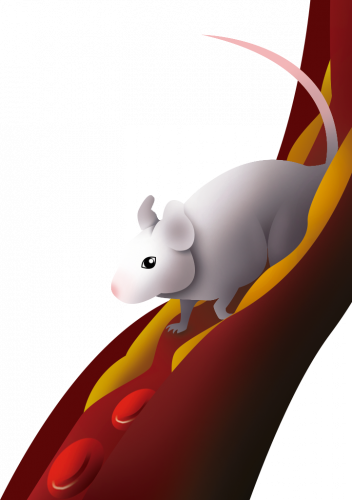Illustration courtesy of Antalique Tran.
Most would consider it common knowledge that exercise enhances physical health and that an active lifestyle reduces risk of heart disease. However, few have been able to demonstrate, on a cellular level, the mechanisms of this relationship between exercise and heart health. This curious ambiguity led Matthias Nahrendorf and his research group at Massachusetts General Hospital and Harvard University in pursuit of answers. Nahrendorf’s group, which studies the interaction between the immune and cardiovascular systems and their subsequent connection to cardiovascular diseases (CVDs), demonstrated that reduced production of inflammatory cytokines and leukocytes is the link between voluntary exercise and improved cardiovascular health.
According to David Rohde, a postdoctoral researcher in Nahrendorf’s lab, and Vanessa Frodermann, a lead author of this publication, researchers who used mice in previous studies targeting the effects of physical exercise on heart health often found increased leukocyte production. In order to convince the mice to exercise, the scientists subjected mice to high-stress scenarios, such as forcing them to run with electric shocks for long periods of time. Such stressful and high intensity practices may have wiped out any beneficial effects of exercise.
Therefore, the Nahrendorf study emphasizes voluntary exercise. “We put running wheels into cages, and the mice run about 7-8 miles each day,” Rohde said. Because this behavior is, surprisingly, voluntary—due to the natural tendency of the mice to run in the wild—they do not experience the detrimental side effects of stress, and the Nahrendorf lab was able to collect concrete evidence that physical activity indeed decreases the production of inflammatory leukocytes.
When researchers compared the proliferation of cells between exercising and sedentary mice, they discovered that voluntary exercise promotes hematopoietic stem and progenitor cell (HSPC) quiescence. HSPCs are stem cells that normally differentiate into blood cells. In exercising mice, HSPCs proliferated less and showed a decreased rate of leukocyte—a type of white blood cell—production. Additionally, these mice exhibited reduced body fat, which resulted in lower adipose expression of the hormone leptin. The bone marrow of the exercising mice expressed higher levels of genes that promote HSPC quiescence and retention. To further investigate this correlation between leptin and HSPC quiescence, researchers elevated the levels of leptin in exercising mice to those in sedentary mice and observed an increase in inflammatory leukocytes and a decline in quiescence gene expression. In contrast, neutralizing the leptin hormone resulted in decreased production of blood cells.
The study found that voluntary exercise not only decreased the risk of CVD in exercising mice during the period of daily exercise, but also induced changes that lasted weeks after the running wheels were withdrawn. These epigenetic changes are a type of DNA modification that affects the activity of genes. Researchers proved the existence of these epigenetics changes by transplanting LSK cells (cell population derived from HSPCs) into irradiated sedentary mice, which resulted in 1.8-fold more circulating leukocytes than transplants with the same cells obtained from exercising mice. This indication that exercise has longer-lasting effects on HSPC differentiation than leptin was attributed to the discovery of reduced DNA accessibility at certain promoter regions associated with transcription and stem cell proliferation in exercising mice. Because these regions also control the cell cycle, nucleosome organization and mRNA processing, these mice maintained these benefits of exercise for up to six weeks after cessation of exercise.
After studying mice, the researchers then examined the association between exercise and plasma leptin levels or white blood cell counts in more than 5,000 study participants. Blood levels of leptin and leukocyte numbers were lowest in participants who exercised either four to six times or two to five hours a week, with less exercise time resulting in suboptimal effects and more time resulting in potentially harmful effects on overworked muscles.
In the long run, this study may enable a new pharmacological approach to improve heart health. Considering the pathway and mechanisms the researchers uncovered, the researchers hope to develop a drug that mimics the effects of exercise, an especially encouraging prospect for older patients and those who are unable to adhere to physically active lifestyles. The complexity of this project lies in the specificity of targeting the discovered mechanism. “While we have figured out the main mechanism, it is much more difficult to target that mechanism,” Rohde said. “Any target has to be very specific, so we are now in the process of screening different cell types.”
Despite advances in medicine, cases of atherosclerosis are steadily rising. This global epidemic is exacerbated by increasingly unhealthy diets and lifestyles. In such a context, the development of a drug that can confer the benefits of exercise could contribute significantly to improving global health.
Citations:
Frodermann, V., Rohde, D., Courties, G. et al. (2019). Exercise reduces inflammatory cell production and cardiovascular inflammation via instruction of hematopoietic progenitor cells. Nat Med, 25. Retrieved from https://www.nature.com/articles/s41591-019-0633-x?draft=collection#citeas.
Rodhe, David. (2020, January 29). Personal Interview.

